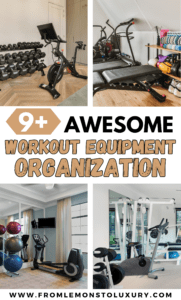9+ Insanely Good Barbell Storage DIY Ideas That Will Elevate Your Home Gym
This site contains affiliate links. I may earn a small commission, at no extra cost to you.
Organizing a home gym can be a daunting task, especially when it comes to Barbell Storage DIY Ideas. Proper storage is essential for keeping the gym space tidy and preventing damage to the barbells or injury to the users. With numerous DIY barbell storage ideas available, individuals can create custom holders to suit their specific needs and preferences.
This article is all about: 9+ Insanely Good Barbell Storage DIY Ideas That Will Elevate Your Home Gym.

These storage solutions can be crafted using various materials, such as wood, PVC, and steel, with options for both vertical and horizontal storage. The type of storage an individual chooses may depend on the available space in their gym and personal preference. By exploring different DIY barbell storage ideas, anyone can find the perfect solution for their home gym.
This article will showcase nine innovative and practical barbell storage ideas, along with step-by-step instructions and tips for successful implementation. Providing an orderly, secure storage solution can improve the functionality of gym spaces and ensure that individuals can focus on their workouts without worrying about clutter.
Best Way to Store Barbells
When it comes to DIY barbell storage ideas, there are several ways to ensure your barbells are stored securely and safely while maintaining functionality and utilizing limited space. Your storage choice should be based on the specific kinds of barbells you have in the gym.
One popular and practical solution is a horizontal wall-mounted barbell rack, which helps to prevent rust, scratches, or wearing down of the knurling. For those who are short on space, a vertical storage rack can also suffice, albeit with a few extra precautions to minimize damage.

A custom barbell storage rack can be constructed using readily available materials like wood, PVC pipes, or steel piping. Wood can provide a sturdy, cost-effective solution but requires regular maintenance and can be sensitive to humidity. PVC pipes are a lightweight, affordable option, suitable for temporary or portable storage needs. Steel provides durability and longevity but can be more expensive and require welding or bolting.
Consider the following DIY barbell storage ideas:
- Concrete Block Storage: This unique design consists of a solid concrete block filled with PVC pipe segments to hold the barbells. It is simple, affordable, and compact.
- PVC Barbell Holders: Create a storage system by attaching PVC pipes to a wall or wooden base. Make sure the pipes are large enough to accommodate the barbells and secure them with appropriate brackets or screws.
- Steel Pipe Barbell Rack: A more robust option is a wall-mounted steel pipe storage system. These can be built using threaded steel pipe pieces, bolted or welded together to create a solid structure.
- Wooden Barbell Rack: This is a classic, functional option, particularly for those with woodworking skills. Craft a wall-mounted wooden rack with notches, dowels, or pegs to hold the barbells securely in place.
Finally, when setting up your DIY barbell storage solution, remember to secure it to the wall or floor to prevent accidents and ensure stability. A well-designed and properly installed barbell storage system will help maintain the lifespan and functionality of your equipment, while also keeping your gym area organized and tidy.
If you don’t have time for a DIY solution, consider this floor mount rack for olympic barbell bars:

Should Barbells Be Stored Vertically or Horizontally
When it comes to storing barbells, the main concern is to maintain their functionality, prevent damage, and save space. Both vertical and horizontal storage options have their merits, and the choice between them depends on factors like the type of barbell, available space, and personal preferences.
Horizontal storage is often considered the best way to store barbells to ensure the longevity of their internal components. Inside the sleeves of a barbell are bushings, bearings, or both, designed to support heavy loads and allow the bar sleeves to spin freely. These anti-friction devices function optimally when the barbell is stored horizontally, as they were designed for this orientation.
Vertical storage can be a practical solution for those with limited space. However, it is essential to ensure that the type of barbell being used can handle vertical storage without the risk of damage. Most importantly, the barbell should not be resting on its bushings or bearings in a vertical holder. This can prevent potential damage to these components over time.
If you’re interested in creating your own vertical barbell storage, a simple DIY idea is to use 2x4s cut into pieces and secured together to form a barbell holder. This design can be adapted to hold multiple barbells by marking and cutting additional slots every 5 inches. Ensure that the holder is sturdy and properly anchored to the wall or floor for safety.
In conclusion, while horizontal barbell storage is often seen as the best option for preserving your equipment, vertical storage solutions can be a good alternative for those with limited space or specific barbell types. DIY vertical barbell holders are an affordable and customizable solution to tailor storage to your specific needs.
Is It Okay to Store a Barbell Vertically
Storing a barbell vertically can be a suitable option for those looking to save space in their gym or workout area. A vertical barbell holder provides an excellent solution for keeping barbells organized and easily accessible while taking up minimal space. When considering vertical storage, it’s essential to address a few critical factors to ensure the safety and longevity of your equipment.
First, it’s important to note that certain types of barbells are better suited for vertical storage. Bars with bushings or needle bearings, such as Olympic bars, can be safely stored in this manner. Fixed-weight barbells or hex bars, on the other hand, should be stored horizontally.
Securing your barbell in a vertical holder can reduce the risk of rust and mild wear on the knurling. A well-designed vertical barbell storage system will have rubber or foam inserts to protect the bar ends from scratches. As long as the storage holder is well-padded and placed away from heavy foot traffic or potential trip hazards, the risk of damaging your barbell is low.
For those interested in designing their own vertical storage solution, a DIY vertical barbell storage system can be built using common materials found at your local hardware store. The key components to consider include:
- Sturdy, load-bearing wood or metal posts for the base and holder.
- Rubber or foam padding to protect the bar ends from scratches and dings.
- Proper spacing between holders to accommodate various barbell lengths and types.
- Anchoring the base to the floor or a stable surface to prevent tipping or falling.
In conclusion, storing a barbell vertically in a well-designed holder is suitable for safely and efficiently organizing your equipment while saving space. By considering your barbell type and implementing protective measures, you can confidently store your barbells vertically without concern for damage or wear.
How to Make a Weight Bar Holder
Constructing a weight bar holder for your home gym is a great way to keep your barbells organized, accessible, and maximize your workout space. Here are some key steps to create your own DIY barbell storage rack.
First, gather the necessary materials. You’ll need the following:
- Select Pine Board
- 2″ PVC Conduit
- 2″ Zinc Countersunk Mending Plates
- #6 – 1″ Flat Head Philips Screws
- 3″ wood screws for mounting the rack to the wall
Next, measure and mark the pine board for PVC holders. Determine the number of holders you need based on the number of barbells you plan to store. Space the holders evenly along the board for optimal balance and weight distribution.
Cut the PVC conduit into sections, sized according to the diameter of your barbells. Place each PVC section on the board’s marks, securing them with two screws and a mending plate. Ensure that the PVC holders are tightly attached to the board, as they will need to support the weight of the barbells.
Now, mount the pine board to the wall using the 3″ wood screws. It’s important to position the rack horizontally, as the sleeves of barbells contain bushings or bearings designed to support heavy loads when the bar is horizontal.
For added stability and strength, consider attaching brackets beneath the PVC holders, ensuring even weight distribution and preventing potential damage to your wall.
Once the rack is securely attached to the wall, carefully place each barbell in its respective PVC holder, ensuring the barbell sleeves are resting on the PVC. With the barbells properly stored in the PVC holders, your DIY barbell storage rack is now ready for use!
By following these simple steps, you can create a practical and efficient storage solution for your home gym, making it easier to access and organize your barbells while exercising.
This article is all about: 9+ Insanely Good Barbell Storage DIY Ideas That Will Elevate Your Home Gym.









